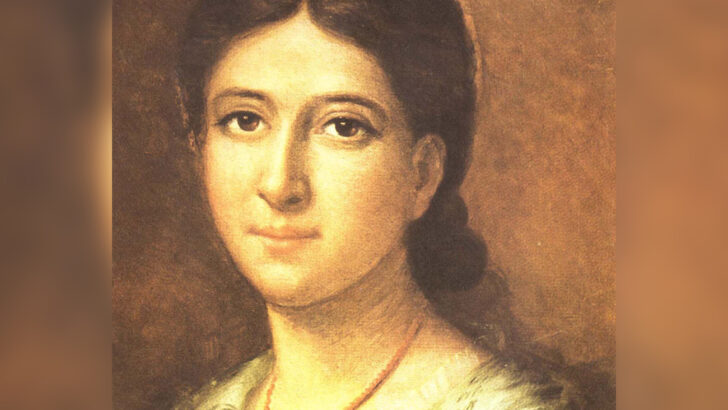D.D. Emmons
In Church history, few lay people have had more positive effect on the success of Catholic worldwide missionary activities than a Frenchwoman named Pauline Jaricot. Born into an aristocratic family in 1799, she used her influence to not only help spread the Gospel but rejuvenate devotion to the rosary and highlight deplorable conditions of the working class.
More than 160 years after her death, the visionary programs Jaricot conceived still resonate and are universally observed throughout the Church. Her life of heroic virtue is exemplified by a pledge of perpetual virginity to Our Lord Jesus Christ, ultimately leading to her beatification in 2022.
As a teenager, Jaricot exhibited zealous interest in the efforts of the French Church to evangelise people in foreign nations, particularly in China.
She wanted to serve in China, but for a variety of reasons, including lifelong poor health, Jaricot never became a foreign missionary. She instead committed herself to fundraising programs that financed the spread of Christianity to places and people unaware of the Gospel.
Around age 19, this prayerful and devout young woman originated a simple yet effective fundraising promotion to support the China mission, a promotion combining prayer and almsgiving.
Persuasion
Using her God-given grace of persuasion, Jaricot committed nine friends, plus herself, to daily praying for the French missionaries in China and to weekly contributing one ‘sou’ (a penny) to that cause. She then asked those friends to solicit 10 of their friends to do the same, and those 10 to ask 10 more and so on; all offered daily prayers and weekly contributions in support of the China missionaries.
She called the groups ‘circles of 10’. This initiative was eventually so productive that in 1822 it was expanded to fund all foreign French missions. Jaricot’s circle of 10 became known as the Society of the Propagation of the Faith and would be adopted by the worldwide Church.
In 1922, Pope Pius XI declared the Society of the Propagation of the Faith as the official fundraising society of the Church and included it as a Pontifical mission. Today, the society assists more than 1,100 Catholic dioceses and is coordinated by the Vatican’s Dicastery for Evangelisation.
All Catholics are asked to continuously pray for our Church missions.
15 coals: one well lighted, three or four partially so and others with no warmth at all. Bring them together and you have a furnace”
In 1826, disheartened by the antireligious culture spawned by the French Revolution, Jaricot began promoting the notion of a living rosary. This idea divides the rosary’s 15 traditional decades among 15 different people who commit to daily praying one decade of a specific mystery. Thus, each group prays daily all the mysteries, and each person involved receives all the graces of the rosary. Those 15 people enlist 15 friends who similarly pray the rosary. Jaricot said of this eagerly received idea, “15 coals: one well lighted, three or four partially so and others with no warmth at all. Bring them together and you have a furnace.”
Canonical
In 1832, Pope Gregory XVI gave canonical status to the Living Rosary Association.
Pauline Jaricot is also forever associated with St Philomena. In 1835, diagnosed with an incurable heart disease, Jaricot was miraculously cured through the intercession of a virgin and martyr named Philomena. Prompted by Jaricot’s well-witnessed cure and other documented miracles ascribed to Philomena, the Vatican in 1837 beatified Philomena.
The Church beatified Philomena based on the numerous documented miracles – the supernatural interventions attributed to her”
This decision was made without historical evidence regarding Philomena’s existence. A tomb inscribed with the name Philomena had been discovered in 1802 and believed to contain the remains of a 13- or 14–year-old second-century virgin and martyr. There were no other confirmable records of Philomena’s life – no evidence of where she lived and no way to trace the kind of life she lived. The Church beatified Philomena based on the numerous documented miracles – the supernatural interventions attributed to her.
This action led to controversy in the 20th century when questions arose as to whether Philomena ever existed. Eventually, the Church removed Philomena from all Church liturgical calendars. While the Church does not promote her, Philomena’s sainthood was never formally denied and Catholics around the world remain devoted to her.
Oppressive
The Industrial Revolution of Jaricot’s era had created oppressive working conditions, low wages and poor treatment among common labourers. Jaricot attempted to finance a factory where workers would be properly paid and treated fairly. She turned her own funds and money she borrowed over to businessmen who embezzled the money and used it for their own profits. She lost everything, was unable to pay back the loans, was bankrupt and died poverty stricken in 1862.
Although the factory project failed, Jaricot’s recognition of the plight of the working class would eventually be substantiated.
Jaricot’s cause for canonisation was opened in 1930, and in 1963 Pope John XXIII declared her venerable”
In 1891, Pope Leo XIII’s encyclical, Rerum Novarum (‘Rights and Duties of Capital and Labor’), addressed the deplorable working conditions and wages of the working class and for the first time involved the Church in social issues.
To those who endeavour in Catholic missions or promote the rosary, Jaricot is a perpetual inspiration. Her life demonstrates what one person of love, faith and conviction can achieve for God’s glory. Jaricot’s cause for canonisation was opened in 1930, and in 1963 Pope John XXIII declared her venerable. She was beatified in 2022 during a Mass celebrated in Lyon, France.


 Bl. Pauline Jaricot
Bl. Pauline Jaricot 